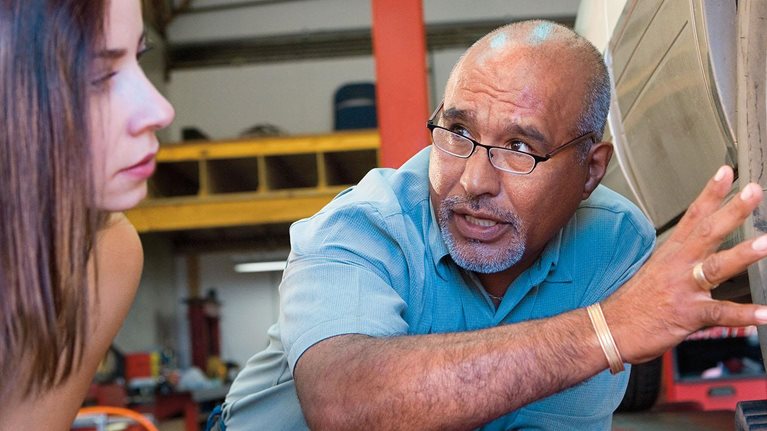Aileen “Lee” Smith leads program operations at the US Department of State’s Passport Services Directorate. Last year the consular services bureau, of which the directorate is part, had the largest single improvement in brand score of US federal agencies measured on customer experience, according to Forrester research. She recently sat down with McKinsey’s Kristin Allstadt and David Malfara to discuss approaches to meeting the challenges of maintaining customer service for a function that relies on large numbers of outside vendors.
Stay current on your favorite topics
McKinsey: Is there a specific department within the bureau that focuses on customer experience?
Aileen Smith: It’s every single one of us. We’ve talked about having a customer-experience office, but there is nothing official right now. We don’t currently have any one department focused on the end-to-end customer experience, largely because we rely on so many outside vendors. Approximately 57 percent, or 9.7 million, of our applications come from partners, including the Postal Service, circuit courts, and public libraries. Passport Services relies 100 percent upon passport-photo vendors. In the end, they are really the ones delivering much of our customers’ application journey.
McKinsey: What is it like trying to effect change when you don’t own large parts of the customer journey?
Aileen Smith: It’s definitely a challenge. For example, we have nearly 8,000 passport-application acceptance facilities nationwide that are not directly managed by us. These facilities processed approximately 8.6 million applications for our customers in fiscal year 2016. For our customers, it doesn’t matter whether they go to their local post office or to a library; it’s all the same government process. However, not all customers may receive a consistent level of customer experience at every location, which is frustrating for us. Among those 8,000 facilities, there are many variables—for example, differing hours of operation, required appointments, or walk-in only. And not all acceptance facilities offer photo services.
For our customers, those facilities are their interaction with the bureau, and we face challenges to deliver a great experience based on the variability in operations. While we do write policy and have oversight into those locations, there is nothing that gives us oversight about the consistency of customer experience, because each location has its own rules about service delivery. We’ve talked about at least having a common appointment system to help drive more consistency for the scheduling process across facilities, because there should be some standard, but right now there isn’t.
McKinsey: You have a new online renewal process. Is it meant to remove that obstacle and make the experience more consistent?
Aileen Smith: Our online renewal process should roll out this year. We believe it will improve consistency by taking the experience out of the hands of outside parties, and as such was a big driver for moving in that direction. We also want to reduce the burden on the applicant. Right now, we push a lot of the effort for applying or renewing onto the customer, so we wanted to make the end-to-end process as easy as possible. The ability to apply online will be much simpler for renewals. In addition, there are cost savings from moving the renewal process online, because we don’t have to receive or process payments through physical operations.
McKinsey: What other priority issues are you focusing on now?
Aileen Smith: We are learning that we don’t currently have a great process to capture valuable insight from customers, so we are trying to start up a function to conduct interviews, have focus groups with customers, and even follow-up on things like Yelp reviews for passport agencies to help with that prioritization process. We’ve also started making a concerted effort to gather feedback directly from employees and contractors, so we can start to build a view of what preferences our customers have in their experience. All of that is in its infancy, but getting better data is definitely our top priority.
In the meantime, we try to categorize and rank order-improvement efforts based on the quantitative data we have from the operation. For example, taking a photo of the customer at the point of accepting their application has become a top priority for us, based on some recent research. We found the number-one reason applications were suspended was due to photo issues. Around 15 percent, or 2.5 million, applications each fiscal year are suspended during the adjudication process, causing delays and more effort on the part of the customer. So we wanted to dig into that process and find ways to improve. Many suspensions are caused by preventable issues like over- or underexposed photos, pictures that were too big or small, or even something as simple as glare on an applicant’s glasses. Based on that information, we are now working with our photo vendors to improve the ability to take quality photos. We are also focusing on taking a secure photo of the customer at the point of accepting their passport. We do live capture of customer photos now in our overseas government-run acceptance offices, and we’ve seen some great technology in places like the Mexican consulates, so we are encouraged that it can be done.
McKinsey: Are you doing anything to engage citizens on this topic in the meantime?
Aileen Smith: We are ramping up communication efforts to customers in order to prevent issues within the existing system. We rolled out a very successful social-media campaign, called #PicturePerfectPassport, that got a lot of visibility. It was largely a visual campaign that communicated passport-photo tips using infographics, videos, GIFs [Graphics Interchange Format images], and other creative content. We designed the campaign based on the top-five reasons passport photos are rejected. So we are approaching the solution from both ends, trying to improve input into the current process while also reducing the customer effort and improving the process on the back end.
McKinsey: What other ways have you applied data to improve the customer’s experience?
Aileen Smith: We’ve recently launched initiatives to improve the communication for the two-parent consent process for children’s passports, based on research we did into Information Request Letters. A customer receives an IRL when we need additional information to continue processing their application. When we reviewed the IRLs to identify the most common issues, we found that there were often errors in applications for children’s passports. In short, if both parents are not available in person to submit the passport application, we need certain documentation to ensure that both parents consent to the process. One of the biggest drivers of IRLs was missing or incorrect documentation to provide two-parent consent, so again we started digging deeper. We cross-referenced the zip codes of the outgoing IRLs with public demographic data available from the US Census Bureau. Given the high volume of IRLs coming from largely Spanish-speaking regions, we made an assumption that a big driver of incorrect two-parent consent documentation was simply due to the language barrier. This drove a couple of changes. First, we already had an executive order to use more plain language on our website, so we used the opportunity to make the page explaining two-parent consent one of the first targets for this effort. Based on the research into language barriers, we have also started the process to interpret all of our content explaining two-parent consent into Spanish. The team that manages IRLs has also started having focus groups with customers to understand the barriers and how we can help make the IRL process easier.

The CEO guide to customer experience
McKinsey: Have you tried incorporating third-party data sources for customer insight?
Aileen Smith: We have a begun a process to use more plain language on our website to clarify information and instructions for our diverse customer base. We’ve recently begun using the Digital Analytics Program to help bring in the voice of the customer and prioritize that process. We use the service to understand which pages are our most commonly viewed and which languages we may need for translation. So far we’ve edited 20 pages to make them more clear and concise, and overall the reading time for each has been cut in half.
We also recently used some direct customer-preference insight to shape our strategy for recruiting acceptance facilities. We conducted direct survey research to understand why customers chose the acceptance facilities they did, and we found that flexibility is a huge deal when it comes to satisfaction. In general, people know that they are going to wait in line to submit a passport application, and they accept that, but they want more flexibility around when they can go. They want to have the option to either make an appointment or walk in. They also want to be able to go after work if they need to. We found that, among our partners, it is not uncommon for libraries to have more flexible hours and offer walk-in services, which results in a very positive customer experience. Based on that, we have been actively recruiting public-library systems by attending national and local library conferences, such as the American Library Association and Public Library Association, and leveraging our solid partnership with participating library systems by having them spread the word among their colleagues. We have established a dedicated email box, posted on our website, where libraries and other potential acceptance facilities can get additional information about our Passport Acceptance Program. As a result, we have signed on about 300 new acceptance facilities.
McKinsey: What advice do you have for other agencies that are on a journey to improve their customer experience?
Aileen Smith: We think about this process like a marathon. You look back from mile 20 and are amazed at the progress, but the whole time, you’ve just been taking little steps. What we’ve done really well is to make good use of our quantitative data and then follow up with qualitative insights to confirm the needs of our customers. We, as government agencies, have to be resourceful. We don’t have the same level of insight, research, or analytics that you’ll find at a Walmart or Target, but we have to do what we can with the information we have available to us. Not every initiative is going to revolutionize the industry, but when you add together all of the improvements we are making, we know that they have an impact.


